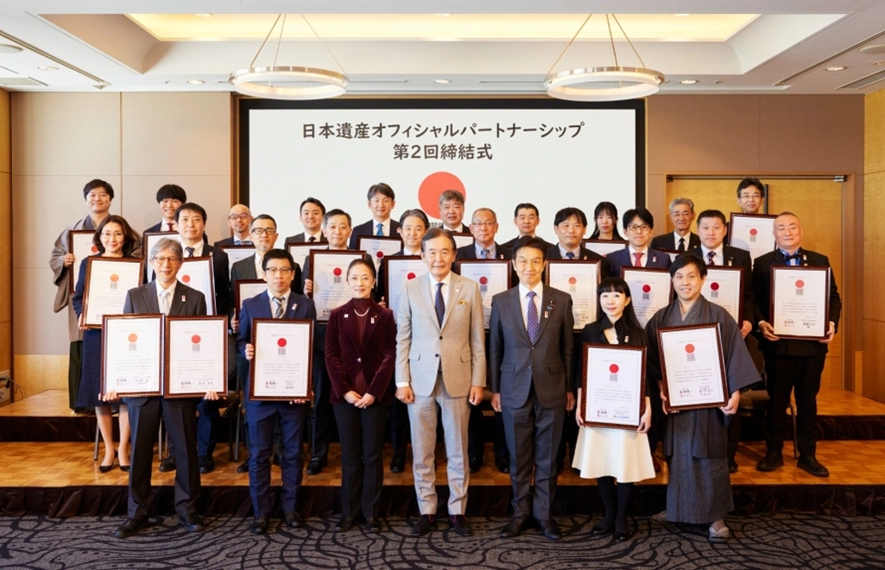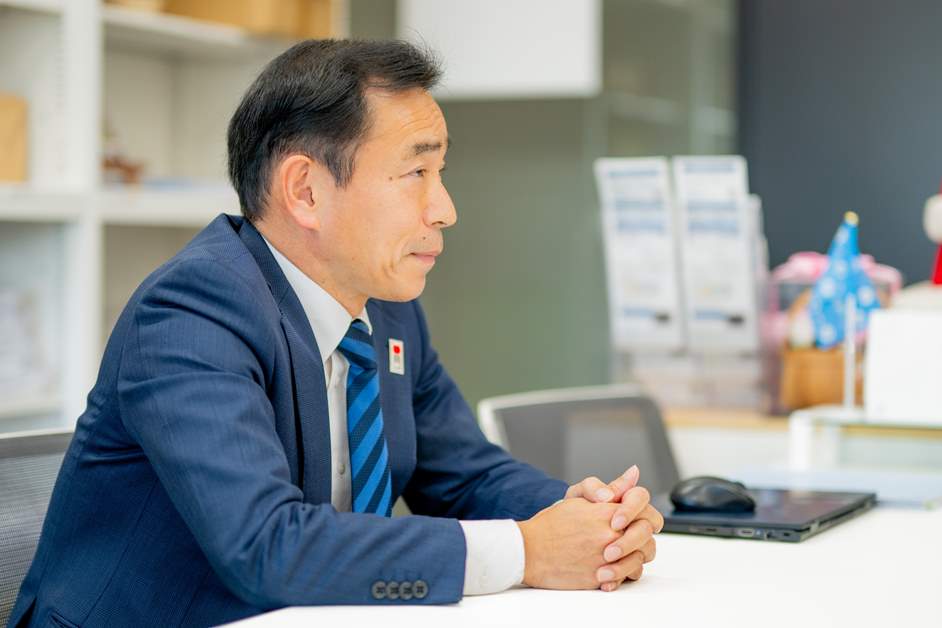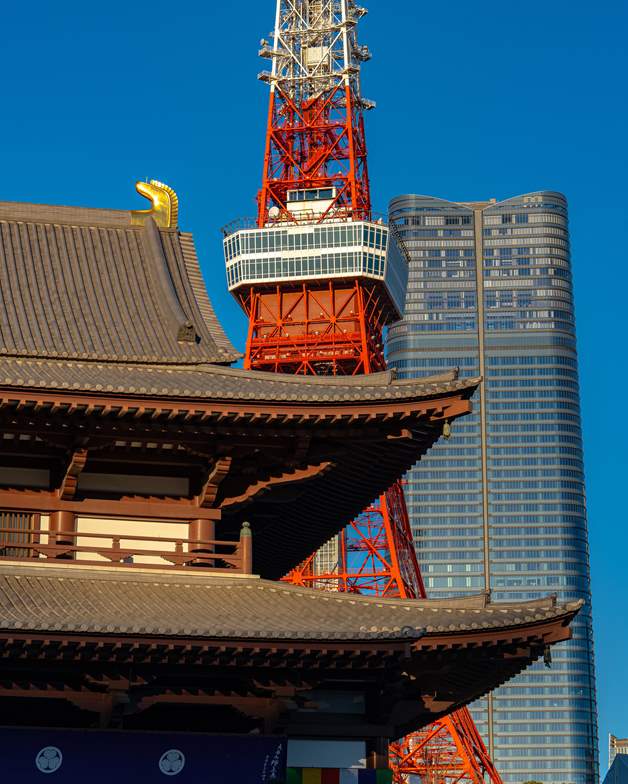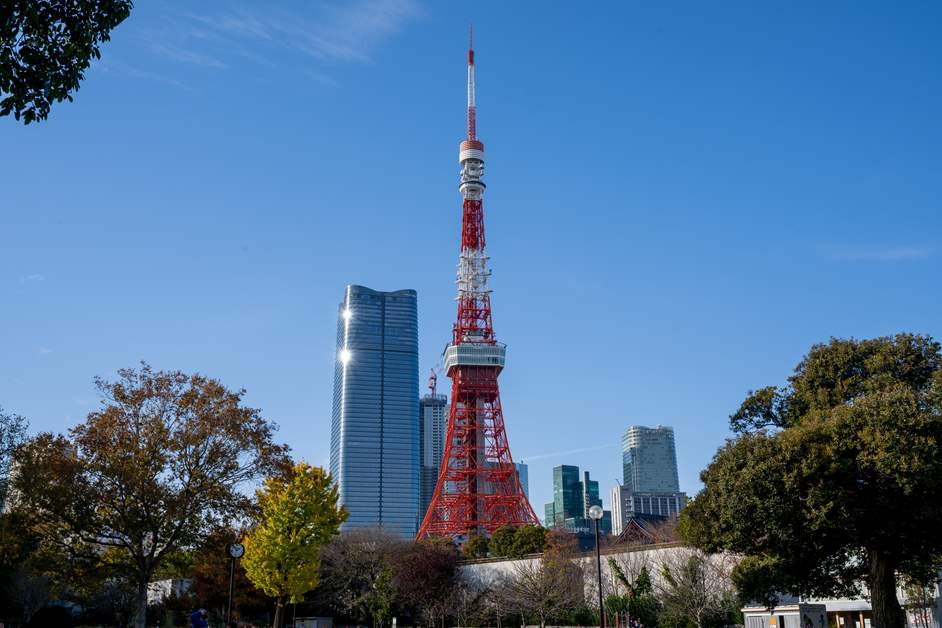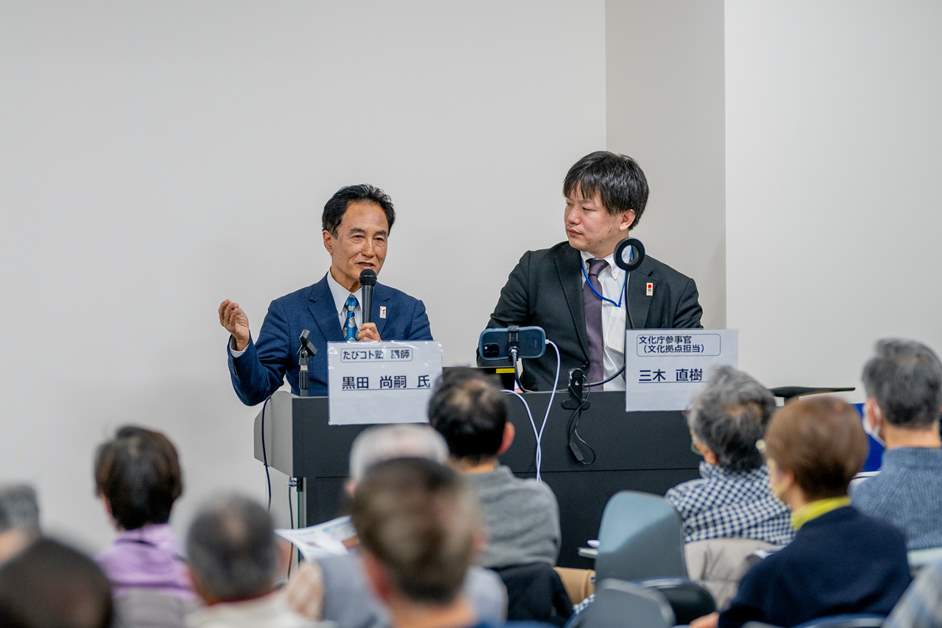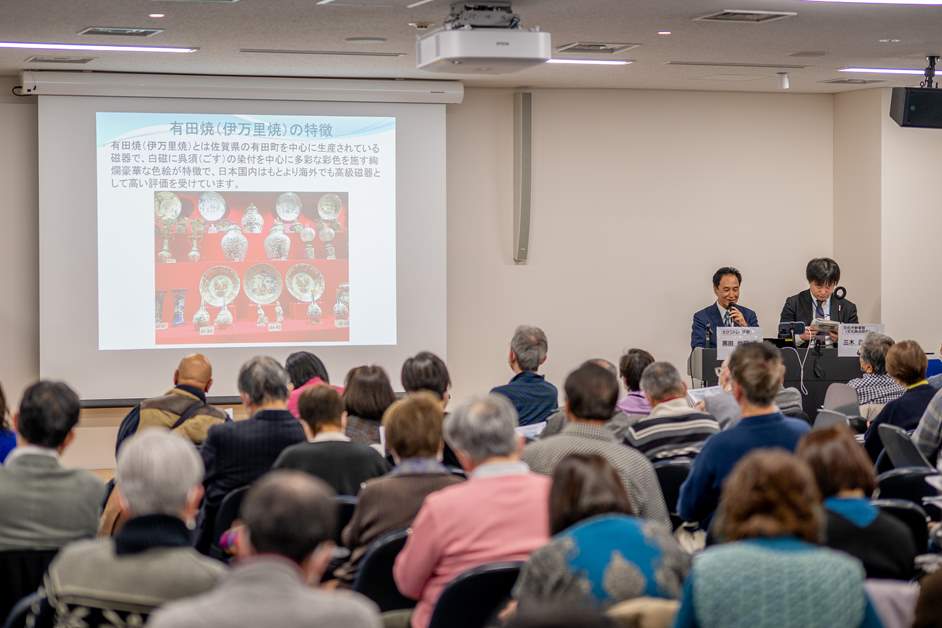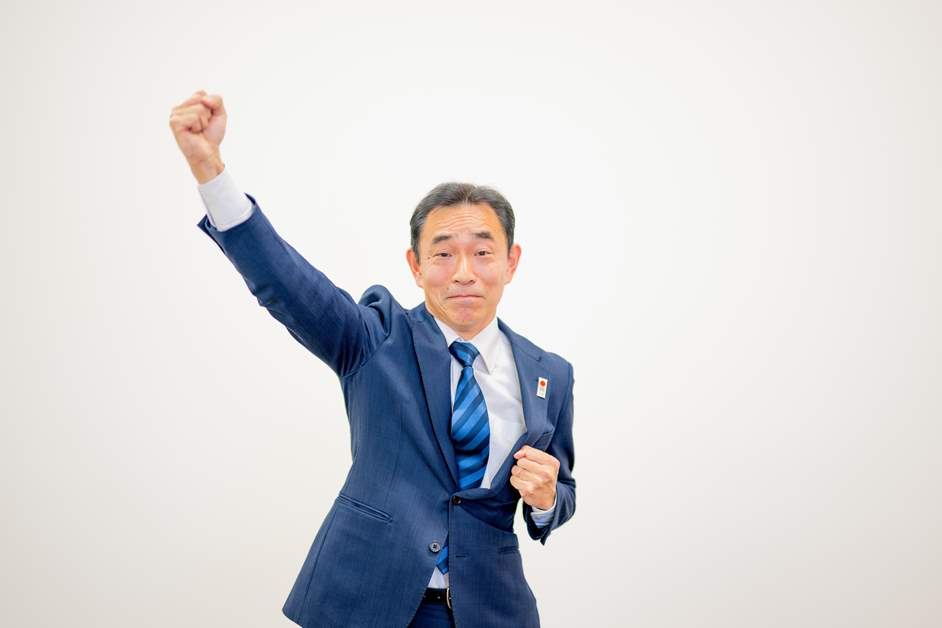Spreading the Appeal of “Japan Heritage” ~Toward Certification of Minato Gateway City as a Japan Heritage Site~
On February 13, 2025, the Agency for Cultural Affairs, Government of Japan (“Agency for Cultural Affairs”) held the 2nd Japan Heritage Official Partnership Program Signing Ceremony whereby the Minato City Tourism Association became an official partner of Japan Heritage. Japan Heritage is an initiative that has been run by the Agency for Cultural Affairs since 2015 that seeks to revitalize local regions of Japan through the dissemination of local culture and tradition. The Agency for Cultural Affairs provides certifications to different regions by bringing together a range of their tangible and intangible assets, including food culture and traditional performing arts, and compiling them into a single coherent story. Thus far, the agency has collected 104 stories in total, covering everywhere from Hokkaido in the north of Japan to Okinawa in the south. The Minato City Tourism Association is a proud supporter of Japan Heritage and seeks to promote the appeal of Japan throughout the country and beyond to the wider world. However, the first step is for Minato City to become a certified Japan Heritage site. For this article, we spoke with Mr. Haruhiko Mogi, who serves as the secretary general of the Minato City Tourism Association, about the movement to get Minato City certified under Japan Heritage and the progress toward that goal.
Reason for Entering into an Official Partnership with Japan Heritage
――Could you start by telling us why the Minato City Tourism Association decided to enter into an official partnership with Japan Heritage?
The Minato City Tourism Association has been making movements to become certified under Japan Heritage since last year. In our efforts to learn more about Japan Heritage and through speaking with many of the people involved with the organization, we realized that one of the challenges facing Japan Heritage is increasing people’s awareness of it. So, our first idea was for the Minato City Tourism Association to lend its support to Japan Heritage by promoting the organization from Gate City - Minato City. That was how we came to apply to become a Japan Heritage official partner.
The Minato City Tourism Association has been making movements to become certified under Japan Heritage since last year. In our efforts to learn more about Japan Heritage and through speaking with many of the people involved with the organization, we realized that one of the challenges facing Japan Heritage is increasing people’s awareness of it. So, our first idea was for the Minato City Tourism Association to lend its support to Japan Heritage by promoting the organization from Gate City - Minato City. That was how we came to apply to become a Japan Heritage official partner.
――Ah, so start by providing support to Japan Heritage. That was how the association came to enter into an official partnership with Japan Heritage, right?
That's correct, yes. The ceremony for the partnership took place on February 13th, which has been designated as Japan Heritage Day, where 25 groups, including ourselves at the Minato City Tourism Association, became official partners of Japan Heritage, bringing the total number of official partners to 57. During the ceremony, Keikyu Corporation and the General Incorporated Association Chiikimirai Kikaku—both of which are also members of our association—entered into official partnerships with Japan Heritage, creating yet more buzz regarding the organization throughout Minato City. I don’t know if you noticed, but I am wearing a special badge today. In becoming an official partner, we are able to use the special logo shown here on the badge, which was created by graphic designer Taku Sato, in our PR activities.
That's correct, yes. The ceremony for the partnership took place on February 13th, which has been designated as Japan Heritage Day, where 25 groups, including ourselves at the Minato City Tourism Association, became official partners of Japan Heritage, bringing the total number of official partners to 57. During the ceremony, Keikyu Corporation and the General Incorporated Association Chiikimirai Kikaku—both of which are also members of our association—entered into official partnerships with Japan Heritage, creating yet more buzz regarding the organization throughout Minato City. I don’t know if you noticed, but I am wearing a special badge today. In becoming an official partner, we are able to use the special logo shown here on the badge, which was created by graphic designer Taku Sato, in our PR activities.
――So, by becoming an official partner, the Minato City Tourism Association is working to spread the appeal of Japan Heritage. What are your goals in entering into such a partnership?
While it is true that, in our efforts to achieve certification as a Japan Heritage site, we saw becoming an official partner as a way to foster a strong relationship with the Agency for Cultural Affairs, we also recognize that Japan Heritage remains relatively unknown on a global scale. That is why we thought that it might be a good idea to use Minato City’s central location at the heart of Tokyo as a way to spread the appeal of Japan Heritage to extremely large numbers of people. The number of inbound foreign tourists into Minato City is steadily rising, after all.
While it is true that, in our efforts to achieve certification as a Japan Heritage site, we saw becoming an official partner as a way to foster a strong relationship with the Agency for Cultural Affairs, we also recognize that Japan Heritage remains relatively unknown on a global scale. That is why we thought that it might be a good idea to use Minato City’s central location at the heart of Tokyo as a way to spread the appeal of Japan Heritage to extremely large numbers of people. The number of inbound foreign tourists into Minato City is steadily rising, after all.
――So, the idea is to use the partnership to help raise and spread awareness of Japan Heritage both at home and abroad?
Exactly. What we would like is for everybody around the world to recognize the name of Japan Heritage as much as you do here. It is important to clarify that Japan Heritage is distinct from UNESCO’s World Heritage list. While the primary goal of World Heritage designation is to preserve and protect cultural assets, Japan Heritage focuses on utilizing these assets to benefit regions within Japan. Japan Heritage is a system that aims to utilize the tangible and intangible cultural assets of different regions, including their history, folklore, and customs to create a regional story that can be used to help revitalize these regions and promote tourism.
Exactly. What we would like is for everybody around the world to recognize the name of Japan Heritage as much as you do here. It is important to clarify that Japan Heritage is distinct from UNESCO’s World Heritage list. While the primary goal of World Heritage designation is to preserve and protect cultural assets, Japan Heritage focuses on utilizing these assets to benefit regions within Japan. Japan Heritage is a system that aims to utilize the tangible and intangible cultural assets of different regions, including their history, folklore, and customs to create a regional story that can be used to help revitalize these regions and promote tourism.
――What exactly were the reasons that the Minato City Tourism Association started aiming for Japan Heritage certification? Could you please provide some background to this?
It all started six or seven years ago when we tried to get Minato City certified as a Japan Heritage site by the Agency for Cultural Affairs with the aim of boosting tourism in the area. Although the aim was for us to acquire this certification, we didn't really have any ideas for a story that could link the area’s specific cultural assets together. Although some of that initial impetus was lost, Mr. Yoshihisa Watanabe, chairman of the Minato City Tourism Association, never gave up on this. As such, there remained within us the ultimate goal of gaining Japan Heritage certification. Japan Heritage has registered 104 stories across Japan; however, the only registered story in Tokyo is Hachioji. As a tourism association, our true goal is for the wards of Tokyo to become certified Japan Heritage sites. Given the nature of Minato City as a location in which progress and culture coexist, we think that there is value in applying for Japan Heritage certification. At the October 2024 board meeting of the tourism association, the officers representing various tourism businesses expressed unanimous support for re-applying, which prompted us to take more decisive action this time around.
It all started six or seven years ago when we tried to get Minato City certified as a Japan Heritage site by the Agency for Cultural Affairs with the aim of boosting tourism in the area. Although the aim was for us to acquire this certification, we didn't really have any ideas for a story that could link the area’s specific cultural assets together. Although some of that initial impetus was lost, Mr. Yoshihisa Watanabe, chairman of the Minato City Tourism Association, never gave up on this. As such, there remained within us the ultimate goal of gaining Japan Heritage certification. Japan Heritage has registered 104 stories across Japan; however, the only registered story in Tokyo is Hachioji. As a tourism association, our true goal is for the wards of Tokyo to become certified Japan Heritage sites. Given the nature of Minato City as a location in which progress and culture coexist, we think that there is value in applying for Japan Heritage certification. At the October 2024 board meeting of the tourism association, the officers representing various tourism businesses expressed unanimous support for re-applying, which prompted us to take more decisive action this time around.
A Story Originating in Minato City Sprinkled with Diverse Cultural Assets
――What kind of story are you helping to tell about Minato City in your application to Japan Heritage?
For example, Hachioji centered their story on Mt. Takao and its silk industry under the Japanese title of “Reiki Manzan - Takao-san ~ Hitobito no Inori ga Tsumugu Soto Monogatari” (Tentative translation: Mountain of Plentiful Spiritual Energy: Mt. Takao ~ The Story of Mulberry City as Woven by the Prayers of its People). We at Minato City are exploring the most compelling story to tell using our vast array of cultural assets. However, with over 300 nationally designated cultural assets in the city, we are still deliberating which ones to feature. History and connections between assets will be an important aspect of our story. The Minato City we know today is a direct product of its history and its culture. The idea for our story is to use the area’s diverse cultural and historical symbols to help have the city recognized as a site of Japan Heritage, which we hope will, in turn, help revitalize the area.However, Minato City, with its abundant cultural and historical legacy and unique customs, presents challenges when it comes to narrowing down a cohesive story. This seems to be a common story as I’ve heard that many of the other regions certified under Japan Heritage had difficulty narrowing down their own stories during their application processes.
For example, Hachioji centered their story on Mt. Takao and its silk industry under the Japanese title of “Reiki Manzan - Takao-san ~ Hitobito no Inori ga Tsumugu Soto Monogatari” (Tentative translation: Mountain of Plentiful Spiritual Energy: Mt. Takao ~ The Story of Mulberry City as Woven by the Prayers of its People). We at Minato City are exploring the most compelling story to tell using our vast array of cultural assets. However, with over 300 nationally designated cultural assets in the city, we are still deliberating which ones to feature. History and connections between assets will be an important aspect of our story. The Minato City we know today is a direct product of its history and its culture. The idea for our story is to use the area’s diverse cultural and historical symbols to help have the city recognized as a site of Japan Heritage, which we hope will, in turn, help revitalize the area.However, Minato City, with its abundant cultural and historical legacy and unique customs, presents challenges when it comes to narrowing down a cohesive story. This seems to be a common story as I’ve heard that many of the other regions certified under Japan Heritage had difficulty narrowing down their own stories during their application processes.
22nd Minato City Tourism Photo Contest 2024; Minato City History Award “From Edo to Reiwa and Beyond” Keisuke Miura
21st Minato City Tourism Photo Contest 2021: Minato City Tourism Association Chairman’s Award “Sengaku-ji Temple in Snow” Ryoichi Sasaki
――It can be difficult sometimes to come up with a story when you have such an abundance of cultural assets.
“However, the elements that comprise a story don't necessarily have to be cultural assets. There is no problem with using the culture and traditions that exist within a region such as its festivals and customs. In a certain sense, you are granted a high degree of freedom and flexibility. Mt. Takao is Hachioji is a mountain and not a cultural asset in and of itself, but it tells a fascinating tale. Also, since it will be Minato City that makes the application, it is important that the thoughts and goals of Minato City are taken into account when forming the story, rather than just those of Minato City Tourism Association. Minato Ward is also home to Tokyo Tower, which is a nationally registered tangible cultural asset and symbol of the city, as well as Zojo-ji Temple—the family temple of the House of Tokugawa—which itself is a symbol of the transition from Edo to Tokyo. Working on this basis, I think one story that we could tell would be that of the transition from the end of the Tokugawa Shogunate at the end of the Edo period and the accompanying opening up of Japan to the modern era and the country’s high economic growth.
“However, the elements that comprise a story don't necessarily have to be cultural assets. There is no problem with using the culture and traditions that exist within a region such as its festivals and customs. In a certain sense, you are granted a high degree of freedom and flexibility. Mt. Takao is Hachioji is a mountain and not a cultural asset in and of itself, but it tells a fascinating tale. Also, since it will be Minato City that makes the application, it is important that the thoughts and goals of Minato City are taken into account when forming the story, rather than just those of Minato City Tourism Association. Minato Ward is also home to Tokyo Tower, which is a nationally registered tangible cultural asset and symbol of the city, as well as Zojo-ji Temple—the family temple of the House of Tokugawa—which itself is a symbol of the transition from Edo to Tokyo. Working on this basis, I think one story that we could tell would be that of the transition from the end of the Tokugawa Shogunate at the end of the Edo period and the accompanying opening up of Japan to the modern era and the country’s high economic growth.
――So, you have to settle on a story before you are finally able to make the application? What is your process for doing this?
When a regional government wants to apply to the Agency for Cultural Affairs to become certified as a Japan Heritage site, it must first meet the application requirements, including having cultural assets that are indispensable to the telling of its story as well as a plan for conserving and utilizing the area’s cultural assets or a basic concept of its history and culture. While we at Minato City would dearly like to be considered as a candidate for Japan Heritage certification, if we do not meet the requirements, then we won’t be able to make the application in the first place. Without the plan for conserving and utilizing an area’s cultural assets, which is a compilation of various plans related to conservation and utilization of cultural assets, you cannot even make it to the start line. However, creating such plans takes both time and money. We hope to collaborate with Minato City and take proactive steps to bring this plan to fruition.
When a regional government wants to apply to the Agency for Cultural Affairs to become certified as a Japan Heritage site, it must first meet the application requirements, including having cultural assets that are indispensable to the telling of its story as well as a plan for conserving and utilizing the area’s cultural assets or a basic concept of its history and culture. While we at Minato City would dearly like to be considered as a candidate for Japan Heritage certification, if we do not meet the requirements, then we won’t be able to make the application in the first place. Without the plan for conserving and utilizing an area’s cultural assets, which is a compilation of various plans related to conservation and utilization of cultural assets, you cannot even make it to the start line. However, creating such plans takes both time and money. We hope to collaborate with Minato City and take proactive steps to bring this plan to fruition.
Road to Certification and Future Prospects
――Are there any regional governments that have already created plans for conserving and utilizing their cultural assets with the aim of achieving Japan Heritage certification?
Yes, there are. If you look at the website of the Agency for Cultural Affairs, you can see that, as of December 20, 2024, 194 regional governments have certified plans for conserving and utilizing their regional cultural assets. There are two types of certification under Japan Heritage: A regional type where the story is concluded within a single municipality and a serial type where the story unfolds across multiple municipalities. In order for Minato City to apply for the regional type of certification, we ultimately have to have completed our plan for the conservation and utilization of our cultural assets. Minato City has even considered collaborating with other wards in Tokyo to pursue the serial type certification. For example, let’s say we were to build a story centered around Katsu Kaishu...Minato City was the place he was most closely associated with, but we could also work together with the other Tokyo wards to tell his larger story as part of a bid to gain the serial type certification. However, if different regional governments choose to collaborate on certification, they may not all share the same level of enthusiasm for the project. It might prove difficult to get everything in line, which may actually hinder efforts toward the end goal.
Yes, there are. If you look at the website of the Agency for Cultural Affairs, you can see that, as of December 20, 2024, 194 regional governments have certified plans for conserving and utilizing their regional cultural assets. There are two types of certification under Japan Heritage: A regional type where the story is concluded within a single municipality and a serial type where the story unfolds across multiple municipalities. In order for Minato City to apply for the regional type of certification, we ultimately have to have completed our plan for the conservation and utilization of our cultural assets. Minato City has even considered collaborating with other wards in Tokyo to pursue the serial type certification. For example, let’s say we were to build a story centered around Katsu Kaishu...Minato City was the place he was most closely associated with, but we could also work together with the other Tokyo wards to tell his larger story as part of a bid to gain the serial type certification. However, if different regional governments choose to collaborate on certification, they may not all share the same level of enthusiasm for the project. It might prove difficult to get everything in line, which may actually hinder efforts toward the end goal.
――It seems as though each regional government will have their own views on which of the serial type and regional type certification is most appropriate for their needs.
It was Mr. Naotsugu Kuroda, a representative auditor of the Japan Heritage Association, who advised us that it might be a good idea for Minato City to apply for the regional certification. As I mentioned earlier, Minato City is not lacking in cultural assets, so I don’t think it should be a problem for us to find what we need in the one place.
It was Mr. Naotsugu Kuroda, a representative auditor of the Japan Heritage Association, who advised us that it might be a good idea for Minato City to apply for the regional certification. As I mentioned earlier, Minato City is not lacking in cultural assets, so I don’t think it should be a problem for us to find what we need in the one place.
――Speaking of Mr. Kuroda, he and Mr. Naoki Miki, Assistant Director at the Agency for Cultural Affairs, gave a talk on Japan Heritage at the KHD Tokyo Building in Shimbashi on February 10th. I believe you also participated, Mogi-san. How did you find it?
There were 110 people who attended the talk, so the venue was packed out. Many senior citizens attended, which I believe reflects the high level of interest in the event. Mr. Kuroda and Mr. Miki presented six Japan Heritage stories relating to three themes, with the idea being to show that knowing the background story of a region can make travel to those places much more fun. Basically, it is more enjoyable to visit somewhere when you know something about it than it is knowing nothing. The event was organized by Hankyu Travel International, who are also members of our association. The event truly embodied Hankyu Travel International’s motto, 'Direct to your heart.
There were 110 people who attended the talk, so the venue was packed out. Many senior citizens attended, which I believe reflects the high level of interest in the event. Mr. Kuroda and Mr. Miki presented six Japan Heritage stories relating to three themes, with the idea being to show that knowing the background story of a region can make travel to those places much more fun. Basically, it is more enjoyable to visit somewhere when you know something about it than it is knowing nothing. The event was organized by Hankyu Travel International, who are also members of our association. The event truly embodied Hankyu Travel International’s motto, 'Direct to your heart.
――Hankyu Travel International are also official partners of Japan Heritage, aren’t they?
The event was held in Hankyu Travel International’s building in Shimbashi and, as I spoke about earlier, there were several businesses from Minato City among the parties who became official partners of Japan Heritage in their 2nd Official Partnership Program. It feels like there in increasing momentum throughout Minato City for gaining Japan Heritage certification, and so we are keen to try out a few things in aid of that.
The event was held in Hankyu Travel International’s building in Shimbashi and, as I spoke about earlier, there were several businesses from Minato City among the parties who became official partners of Japan Heritage in their 2nd Official Partnership Program. It feels like there in increasing momentum throughout Minato City for gaining Japan Heritage certification, and so we are keen to try out a few things in aid of that.
――What do you foresee happening in the coming period?
Of course, our chief aim is to become certified as a Japan Heritage site; however, it cannot simply end there. It is also important that we look at how we can use PR to raise awareness of Minato City and Japan Heritage certification. The Minato City Tourism Association has been collecting data on people flows for the past two years. This should enable us to visualize both the number of visitors and the tourism-related consumer spending before and after certification, providing a foundation for implementing other data-driven initiatives. Ultimately, the goal should be not only to attract visitors to Minato City as a Japan Heritage site but also to position the city as a gateway for exploring other Japan Heritage-certified regions. It might be worthwhile to create a guidebook showcasing Japan Heritage sites across the country.
Of course, our chief aim is to become certified as a Japan Heritage site; however, it cannot simply end there. It is also important that we look at how we can use PR to raise awareness of Minato City and Japan Heritage certification. The Minato City Tourism Association has been collecting data on people flows for the past two years. This should enable us to visualize both the number of visitors and the tourism-related consumer spending before and after certification, providing a foundation for implementing other data-driven initiatives. Ultimately, the goal should be not only to attract visitors to Minato City as a Japan Heritage site but also to position the city as a gateway for exploring other Japan Heritage-certified regions. It might be worthwhile to create a guidebook showcasing Japan Heritage sites across the country.
――And the first step toward that goal is to submit your application and become certified.
Exactly. We at the Minato City Tourism Association are sincere in our desire to convey the heritage status of Minato City as a gateway city to the rest of Japan. While I am just echoing the sentiments expressed by our chairman, Watanabe-san, Minato City really is evolving at a rapid pace. But, even as the city evolves, certain traditions must be preserved for future generations. In pursuit of this goal, we are committed to collaborating with the regional government to secure Japan Heritage certification. We have received the full support of the Agency for Cultural Affairs, the Tokyo Metropolitan Government, and many of the businesses in Minato City. We at the Minato City Tourism Association have set our business theme for fiscal year 2025 as 'Evolution and Fusions of Culture in Promoting Tourism to Minato City: A Story Unifying the City's Appeal Across Eras.'
Please rest assured that we are working diligently to achieve Japan Heritage certification.
Exactly. We at the Minato City Tourism Association are sincere in our desire to convey the heritage status of Minato City as a gateway city to the rest of Japan. While I am just echoing the sentiments expressed by our chairman, Watanabe-san, Minato City really is evolving at a rapid pace. But, even as the city evolves, certain traditions must be preserved for future generations. In pursuit of this goal, we are committed to collaborating with the regional government to secure Japan Heritage certification. We have received the full support of the Agency for Cultural Affairs, the Tokyo Metropolitan Government, and many of the businesses in Minato City. We at the Minato City Tourism Association have set our business theme for fiscal year 2025 as 'Evolution and Fusions of Culture in Promoting Tourism to Minato City: A Story Unifying the City's Appeal Across Eras.'
Please rest assured that we are working diligently to achieve Japan Heritage certification.
<Japan Heritage Portal Site>
https://japan-heritage.bunka.go.jp/ja/
https://japan-heritage.bunka.go.jp/ja/




